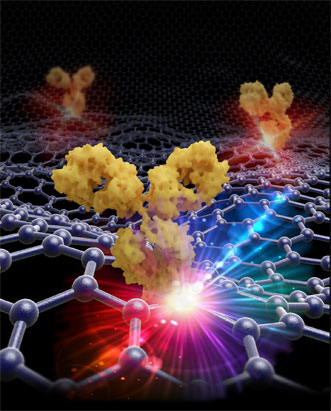A plasmonic sensor made of graphene can conduct complex analyses of the smallest molecules without altering them.
The device overcomes a limitation of traditional IR absorption spectroscopy, according to researchers at the Swiss Federal Institute of Technology in Lausanne (EPFL) and The Institute of Photonic Sciences in Spain (ICFO).
Widely used for detecting larger molecules, the technique has been ineffective for detecting nanoscale molecules like proteins because mid-infrared wavelengths, around 6 μm, are much larger than the objects to be detected.
This difference in scale can be overcome with graphene, which exhibits light confinement two orders of magnitude higher than other metals, the researcher said.

Causing graphene's electrons to oscillate in different ways makes it possible to read all the vibrations of a molecule on its surface. Courtesy of EPFL/Miguel Spuch/ Daniel Rodrigo.
"We first pattern nanostructures on the graphene surface by bombarding it with electron beams and etching it with oxygen ions," said Daniel Rodrigo, a postdoctoral researcher at EPFL. "When the light arrives, the electrons in graphene nanostructures begin to oscillate. This phenomenon, known as localized surface plasmon resonance, serves to concentrate light into tiny spots, which are comparable with the dimensions of the target molecules. It is then possible to detect nanometric structures."
The process can also reveal the nature of bonds connecting the atoms within the molecules, based on their refractive indices and vibrational frequencies.
"These vibrations act as a fingerprint that allows us to identify the molecule, such as proteins, and can even tell their health status," said Odeta Limaj, also a postdoctoral research at EPFL.
The graphene can be tuned to different frequencies by applying voltage, which is not possible with current sensors. Causing graphene's electrons to oscillate in different ways makes it possible to read all the vibrations of a molecule on its surface.
Developed primarily with biomolecules in mind, the sensor could also be used to detect gas and explosives and to study polymers, said ICFO professor Valerio Pruneri and EPFL professor Hatice Altug.
"This is because graphene is an inert material for the elements to be detected, and the reading mechanism uses light which is free of any interference effect," Pruneri said.
The research was published in Science (doi: 10.1126/science.aab2051).
For more information, visit www.epfl.ch and www.icfo.eu.